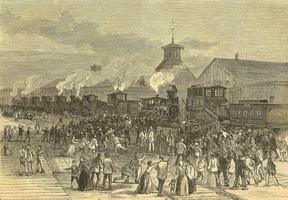 | Back to e-WV
| Back to e-WV
 The West Virginia Encyclopedia
The West Virginia Encyclopedia
 | Back to e-WV
| Back to e-WV
 The West Virginia Encyclopedia
The West Virginia Encyclopedia

The Panic of 1877, a national economic recession, had a disastrous effect on the earnings of the Baltimore & Ohio Railroad. In response, the railroad announced a ten percent pay cut for all employees. The pay cut exacerbated earlier wage cuts, and the railroad firemen’s union called a strike which soon spread along the rails from Baltimore to Chicago.
The first violence occurred in West Virginia, when strikers in Martinsburg attempted to stop trains from running. Governor Mathews quickly mobilized the militia company in Martinsburg to control the strikers. The unit was commanded by Capt. Charles J. Faulkner Jr., and was made up largely of volunteers who were railroad workers themselves or related to railroad workers. Consequently, the militiamen were subjected to extreme pressure from relatives and fellow workers. The unit was assigned to guard a train that attempted to leave the railroad yard in Martinsburg. A striker fired upon the militiamen and was mortally wounded by return fire. The militia then withdrew and refused to take further action against the strikers.
Mathews sent another militia unit from Wheeling to the scene, and when the Wheeling unit also proved unable to handle the strikers he called upon President Rutherford B. Hayes for federal troops to preserve order. Mathews went to Martinsburg on July 18, and the federal troops arrived the next day. The federal troops were successful in ending the violence at Martinsburg, and the strike ended later in the summer of 1877. The strike showed that West Virginia authorities were ill-prepared to handle unrest among laboring groups and led to calls, mostly unheeded, for development of a professional national guard to control labor disturbances.
Written by Kenneth R. Bailey
Bailey, Kenneth R. Mountaineers are Free: A History of the West Virginia National Guard. St. Albans: Harless Printing, 1978.
Bruce, Phillip V. 1877, Year of Violence. Indianapolis: Bobbs- Merrill, 1959.
Hungerford, Edward. The Story of the Baltimore and Ohio Railroad, 1827-1927. New York: G. P. Putnam Sons, 1928.